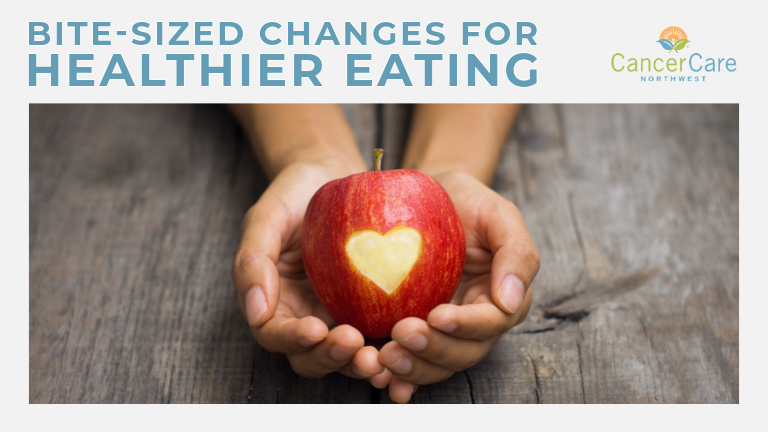
Bite-Sized Changes for Healthier Eating
Posted: January 23, 2024
How many times have you started the year saying, “new year, new me”, but didn’t know where to start? Or felt overwhelmed by all the nutrition information you read on the internet? Maybe you found yourself back in your old habits by February (or sooner) because the changes made you miserable. If you can’t (or don’t want to) maintain a change over time, you are unlikely to experience any benefit from it. Instead, focus on small, sustainable modifications to your current eating pattern.
- Add more vegetables to your meals. Whether you’re making macaroni and cheese or lasagna and anything in between, toss in some vegetables. They add needed fiber and nutrients that combat chronic disease and help you feel full on less calories. Short on time? Toss in a bag of frozen vegetables; they are just as nutritious as fresh.
- Snack on fruit. Fruit is portable and shelf stable. Have your apple with some peanut butter or cheese – the protein will keep you full longer. Fruit and cottage cheese is another good combination.
- Create a standard grocery list and replenish your stock as needed. Remember the saying “don’t shop on an empty stomach”? People tend to buy more unhealthy snacks and things off their shopping list when they go without a plan. Instead, plan for what meals you want to make for the week and buy what you need for them. This can save you money and prevent food waste. Avoid being caught unprepared by keeping a standard grocery list of things you eat regularly and replenish as needed.
- Swap high-fat ingredients for lower fat alternatives. You can save calories simply by swapping your whole fat milk for non-fat or low-fat versions (have you considered almond, oat, soy, or coconut milk?); use light-mayo or avocado in place of full-fat mayonnaise.
- Choose 100% whole grain in place of refined grains. They can be chewier/denser than their white flour counterparts, but 100% whole-grains provide fiber, B vitamins, and phytochemicals beneficial to your health that white flour products do not.
- Choose different proteins.
- You may be used eating beef or pork with many of your meals, but did you know that the American Institute for Cancer Research (AICR) recommends we limit how much red meat we eat to less than 12-15 ounces per week, and having processed meats like bacon or deli meat only on special occasions?
- If your recipe calls for beef or pork, try using these alternatives instead: chicken, turkey, fish, or plant-based proteins like beans.
- Examples: ground turkey is an excellent substitute for ground beef in tacos and meatloaf. Try a tuna or chicken salad sandwich made with light mayo instead of sandwich with deli meat.
- Reduce how much sugar-sweetened beverages you drink.
- While sugar is not a direct cause of cancer, over-consumption of it can lead to weight gain and inflammation, both of which are tied to increased risk for cancer. A single 12-oz can of soda contains around 40 grams of sugar – or 10 teaspoons! Don’t forget about energy drinks – some have over 13 teaspoons of sugar.
- Try these ideas instead: create water infusions with bright flavors of fruit, herbs, and vegetables. Choose lower-sugar juice options or dilute them by using ½ cup juice and ½ cup water instead of full strength.
- Try keeping a food log. This is often the first step for those who would like to lose weight. To lose weight, you need to take in less calories than you are using. Tracking what you eat can not only help you see how much and what you’re eating, but it can also be a window to when and why you’re eating. Are you snacking while watching TV and not paying attention to how much you’re consuming? Do you grab something to eat when you’re bored? These are common habits and may be preventing you from reaching your goals.
